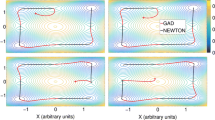Abstract
The subject of multidimensional potential surfaces and the dynamics on those surfaces was just reviewed by this writer 1, and the closely related topic of the analytic representation of potential surfaces, largely of small systems, had been reviewed shortly before by Schatz2. Consequently we will here very tersely review some of the fundamentals, briefly survey aspects of the subject treated in those reviews and discuss some aspects not covered in those reviews.
Access this chapter
Tax calculation will be finalised at checkout
Purchases are for personal use only
Preview
Unable to display preview. Download preview PDF.
Similar content being viewed by others
References
R. S. Berry, Potential Surfaces and Dynamics: What Clusters Tell Us, Chem. Revs, (in press): (1993).
G. C. Schatz, The analytic representation of electronic potential energy surfaces, Revs. Mod. Phys. 61: 669 (1989).
B. Sutcliffe, The coupling of nuclear and electronic motions in molecules, J. Chem. Soc. Faraday Trans. 89: 2321 (1993).
J. N. Murrell, S. Carter, S. C. Farantos, P. Huxley and A. J. C. Varandas. “Molecular Potential Energy Functions,” Wiley, New York (1984).
D. M. Hirst. “Potential Energy Surfaces,” Taylor and Francis, London (1985).
T. H. Dunning Jr. and L. B. Harding, in: “Theory of Chemical Reaction Dynamics,” M. Baer. ed., CRC Press, Boca Raton, Florida (1985).
J. E. Lennard-Jones, Proc. Roy. Soc. A. 106: 463 (1924).
R. A. Aziz and H. H. Chen, J. Chem. Phys. 67: 5719 (1977).
R. A. Aziz, Molec. Phys. 38: 177 (1979).
R. A. Aziz and M. J. Slaman, The argon and krypton interatomic potentials revisited, Mol. Phys. 58: 679 (1986).
R. A. Aziz, A highly accurate interatomic potential for argon, J. Chem. Phys. 99: 4518 (1993).
M. P. Tosi and F. G. Fumi, J. Phys. Chem. Solids. 25: 45 (1964).
D. O. Welch, O. W. Lazareth, G. J. Dienes and R. D. Hatcher, Alkali halide molecules: configurations and characteristics of dimers and trimers, J. Chem. Phys. 64: 835 (1976).
D. O. Welch, O. W. Lazareth, G. J. Dienes and R. D. Hatcher, Clusters of alkali halide molecules, J. Chem. Phys. 68: 2159 (1978).
R. S. Berry, Optical Spectra of the Alkali Halide Molecules, in: “Alkali Halide Vapors,” P. Davidovits and D. L. McFadden. ed., Academic Press, New York (1979).
W. H. Press, B. P. Flannery, S. A. Teukolsky and W. T. Vetterling. “Numerical Recipes,” Cambridge University Press, Cambridge (1986).
J. W. Mclver Jr. and A. Komornicki, Structure of Transition States in Organic Reactions. General Theory and an Application to the Cyclobutene-Butadiene Isomerization Using a Semiempirical Molecular Orbital Method, J. Am. Chem. Soc. 94: 2625 (1972).
A. Komornicki and J. W. McIver Jr., J. Am. Chem. Soc. 95: 4512 (1973).
A. Komornicki and J. W. McIver Jr., Structure of Transition States. III. A MINDO/2 Study of the Cyclization of 1, 3, 5-Hexatriene to 1, 3-Cyclohexadiene, J. Am. Chem. Soc. 96: 5798 (1974).
J. W. Mclver, The Structure of Transition States: Are They Symmetric?, Acc. Chem. Res. 7: 72 (1974).
J. Pancik, Calculation of the Least Energy Path on the Energy Hypersurface, Coll. Czech. Chem. Comm. 40: 1112 (1975).
H. Pop**er, On the Calculation of Transition States, Chem. Phys. Lett. 35: 550 (1975).
T. A. Halgren and W. N. Lipscomb, The Synchronous Transit Method for Determining Reaction Pathways and Locating Molecular Transition States, Chem. Phys. Lett. 49: 225 (1977).
P. G. Mezey, M. R. Peterson and I. G. Csizmadia, Transition state determination by the X-method, Can. J. Chem. 55: 2941 (1977).
K. Müller and L. D. Brown, Location of Saddle Points and Minimum Energy Paths by a Constrained Simplex Optimization Procedure, Theor. Chim. Acta (Berl.). 53: 75 (1979).
W. H. Miller, N. C. Handy and J. E. Adams, Reaction path Hamiltonian for polyatomic molecules, J. Chem. Phys. 72: 99 (1980).
C. J. Cerjan and W. H. Miller, On finding transition states, J. Chem. Phys. 75: 2800 (1981).
D. O’Neal, H. Taylor and J. Simons, Potential Surface Walking and Reaction Paths for C2vBe + H2<- BeH2-> Be + 2H (1A1), J. Phys. Chem. 88: 1510 (1984).
J. Simons, P. Jørgenson, H. Taylor and J. Ozment, Walking on Potential Energy Surfaces, J. Phys. Chem. 87: 2745 (1983).
J. Baker, An Algorithm for the Location of Transition States, J. Comp. Chem. 7: 385 (1986).
R. S. Berry, H. L. Davis and T. L. Beck, Finding saddles on multidimensional potential surfaces, Chem. Phys. Lett. 147: 13 (1988).
R. S. Berry, How We and Molecules Explore Molecular Landscapes, in: “Mode Selective Chemistry,” J. Jortner, A. Pullman and B. Pullman, ed., Kluwer Academic Publishers, Amsterdam (1991).
D. J. Wales, Transition States for Ar55, Chem. Phys. Lett. 166: 419 (1990).
D. J. Wales, Locating Stationary Points for Clusters in Cartesian Coordinates, J. Chem. Soc. Faraday Trans. 89: 1305 (1993).
J. Rose and R. S. Berry, Towards elucidating the interplay of structure and dynamics in clusters: Small KC1 clusters as models, J. Chem. Phys. 96: 517 (1992).
R. S. Berry, “Atomic Clusters: Laboratories for Studying Chaos and Ergodicity,” in Proc. Adriatico Research Conference “Mesoscopic Systems and Chaos, a Novel Approach,”, Trieste, 1993, H. Cerdiera and G. Casati, ed., World Scientific, Singapore (1994).
J. Rose and R. S. Berry, (KC1)32 and the possibilities for glassy clusters, J. Chem. Phys. 98: 3262 (1993).
J. P. Rose and R. S. Berry, Freezing, Melting, Nonwetting and Coexistence in (KC1)32, J. Chem. Phys. 98: 3246 (1993).
Author information
Authors and Affiliations
Editor information
Editors and Affiliations
Rights and permissions
Copyright information
© 1994 Springer Science+Business Media New York
About this chapter
Cite this chapter
Berry, R.S. (1994). Exploring Potential Surface Landscapes and How they Govern Dynamics. In: Christophorou, L.G., Illenberger, E., Schmidt, W.F. (eds) Linking the Gaseous and Condensed Phases of Matter. NATO ASI Series, vol 326. Springer, Boston, MA. https://doi.org/10.1007/978-1-4615-2540-0_16
Download citation
DOI: https://doi.org/10.1007/978-1-4615-2540-0_16
Publisher Name: Springer, Boston, MA
Print ISBN: 978-1-4613-6083-4
Online ISBN: 978-1-4615-2540-0
eBook Packages: Springer Book Archive




